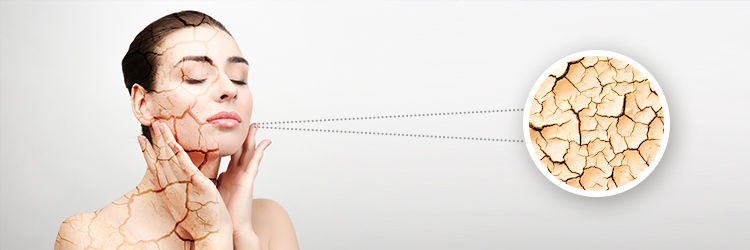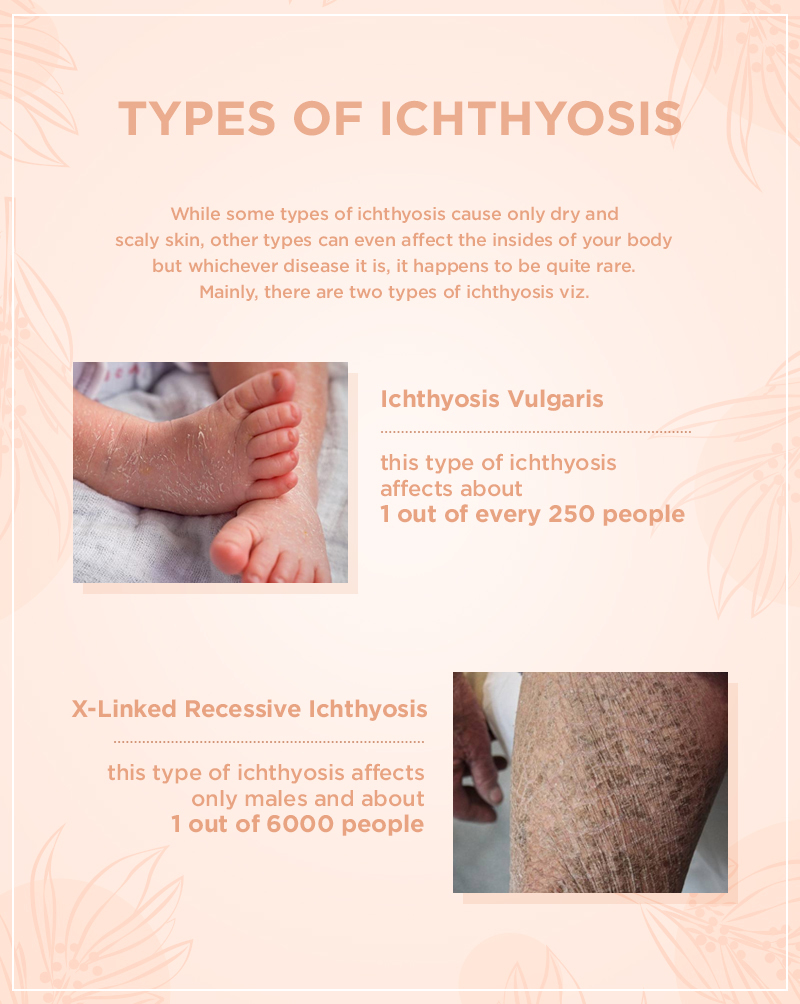If you thought winters are the only thing that can leave your skin dry and flaky, by stripping your skin of its moisture, you need to reassess. There are many things, from cold air to chlorine in swimming pools, which can leave your skin feeling dry, scaly, and flaky. A group of skin diseases that cause dryness and scaling are called ichthyosis. Although there is no permanent cure for ichthyosis, there are certain treatments available that can relieve your skin of the symptoms that cause dry, scaly skin. It is basically a group of twenty skin infections categorized under one main type of skin disease. The protective barrier that locks the moisture in your skin is harmed when your skin is affected by any of these twenty skin infections under ichthyosis. Furthermore, new skin cells are formed rather quickly as compared to the old skin cells that are shed away too slowly which eventually leads to the build-up of thick, scaly skin which looks like fish scales. This is the main reason why ichthyosis is commonly referred to as a fish disease and the name is derived from the Greek word for fish.
Ichthyosis or dry, scaly skin is a tricky disease that, if not cared for, can affect your quality of life. There are many forms of this disease, but also various skincare tips and ways to treat it. Understanding how this disease works and how to treat it is the first step to improving your skin and health. Also, understanding the different types and causes contributes to how you treat this type of skin disease.
Types of Ichthyosis
What Is Ichthyosis Vulgaris?
Ichthyosis Vulgaris, meaning common fish disease, is a skin disease that causes dry, scaly, and discoloured patches of skin on the body. These patches often appear in areas such as the elbows, knees, and shins. Symptoms of Ichthyosis Vulgaris include:
- Itchy skin
- Flaky, dry skin
- Patches of skin in the likeness of scales
- Thickened skin
- Grey, white, or brown patches of discoloured skin
- Ichthyosis Vulgaris
- Harlequin Ichthyosis
- Epidermolyctic Ichthyosis
- Lamellar Ichthyosis
- X-linked Ichthyosis
- Acquired Ichthyosis
Types of Ichthyosis
There are 6 main types of Ichthyosis, including:
The most common type of Ichthyosis normally occurs in the early years of development when scales of thick skin appear all over the body.
An inherited condition of the skin where a baby is born with large patches of scaly-looking skin. These babies are prone to skin infections, breathing problems, and even eating impediments.
Where a baby is born with red, delicate, and sensitive skin. They develop scales of dry skin later in life, such as in early childhood and puberty.
New-born babies with this type of skin disorder are covered in a thick membrane at birth. They usually shed this membrane shortly after birth, but the scales are still present on the body.
Scales appear on a newborn shortly after birth.
A non-inherited skin condition that occurs by internal diseases and medication reactions.
Causes of Ichthyosis Vulgaris
Most causes of Ichthyosis are caused by gene mutations carried from generation to generation.
Scales appear on the skin as a result of the lack of filaggrin, a skin protein responsible for the skin’s natural protectant and pH levels. Without the proper function and regeneration of this protein, the skin cannot produce enough moisture, and the pH levels become unbalanced.
But there are two ways by which one can get affected by ichthyosis, either it is inherited or acquired.
Inherited ichthyosis is caused by gene mutations or changes. Genes are the foundation that tells the body how to make proteins and even determine how your body functions and looks. When affected by ichthyosis, the gene mutations affect the proteins that protect the skin and retain its moisture. These gene mutations also determine how quickly your skin cells multiply or get shed. Usually, parents pass on the genes to the children and sometimes even children whose parents do not have ichthyosis can get this disease even before birth. This happens due to the gene mutation inside the egg or the sperm and such is called spontaneous mutations. However, sometimes there are certain people might have the gene mutation but do not show any symptoms. These gene mutations are called carriers.
Acquired ichthyosis is usually caused in adulthood and the one particular cause behind it is yet to be determined.
Anyone suffering from acquired ichthyosis can also show other symptoms and or have other skin conditions such as,
Inherited ichthyosis is caused by gene mutations or changes. Genes are the foundation which tells the body how to make proteins and even determine how your body functions and looks. When affected by ichthyosis, the gene mutations affect the proteins that protect the skin and retain its moisture. These gene mutations also determine how quickly your skin cells multiply or get shed. Usually, parents pass on the genes to the children and sometimes even children whose parents do not have ichthyosis can get this disease even before birth. This happens due to the gene mutation inside the egg or the sperm and such is called spontaneous mutations. However, sometimes there are certain people might have the gene mutation but do not show any symptoms. These gene mutations are called carriers.
Acquired ichthyosis is usually caused in adulthood and the one particular cause behind it is yet to be determined.
Anyone suffering from acquired ichthyosis can also show other symptoms and or have other skin conditions such as,
- Inherited Ichthyosis
- Acquired Ichthyosis
- Underactive thyroid gland
- Kidney disease
- Sarcoidosis, a rare disease that causes patches of inflammation inside the body
- Cancer such as Hodgkin lymphoma
- HIV infection
Treatment of Ichthyosis Vulgaris

Immediately following a bath or a shower, you should follow up with a moisturizer that contains the active ingredients urea or propylene glycol to help balance your skins pH levels and retain moisture.
Brush your scalp or pumice your skin with a stone to help exfoliate the skin and encourage skin regeneration.
These should contain lactic acid or high volumes of vitamin A to help slow down the production of skin cells.
Immediately following a bath or a shower, you should follow up with a moisturizer that contains the active ingredients urea or propylene glycol to help balance your skins pH levels and retain moisture.
Brush your scalp or pumice your skin with a stone to help exfoliate the skin and encourage skin regeneration.
These should contain lactic acid or high volumes of vitamin A to help slow down the production of skin cells
- Heavy Moisturization:
- Brushing and Washing:
- Prescription Treatments:
Religiously applied and dedicated treatments help prevent skin cracking, skin infections, and promotes better-hydrated skin, and could even prevent the skin from further scaling.
Note that any type of ichthyosis is not necessarily life-threatening, but it can surely have some effect on your life. Dermatologists will surely recommend treatments that will help your skin heal and look better but only an expert can give you the correct guidance. If you want to know more about skin and hair treatments, read more on the Skin and Hair Academy website for more information about Ichthyosis and other skin disorders that affect you and even get in touch with an expert dermatologist or skin doctor near you.















